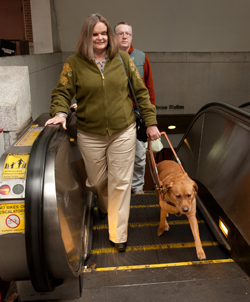How the ADA changed my life: when discrimination occurs, I have back-up
by Donna
 So what does 25 years of having a law to protect my civil rights mean to me? What changes have I noticed? What else needs doing?
So what does 25 years of having a law to protect my civil rights mean to me? What changes have I noticed? What else needs doing?
I was 31 when Congress decided that my right to equal access to employment, health care, movie theaters, restaurants, public transportation, and telecommunications needed to be affirmed and protected by legislation. By that time, I already had a college degree, had been working for 11 years, was the mother of an 8-year-old child, and had been riding the bus to work for six years.
So the passage of the Americans with Disabilities Act (ADA), while recognizably momentous, was for me less an “aha” moment and more a moment of weary satisfaction. The sense of accomplishment 25 years ago was tempered by the knowledge that the distance between the passage of civil rights legislation and the implementation of nondiscriminatory action was still quite a socio-hike.
Maybe I can describe it this way. I have carried the label of “disability” for 56 years. I think of the history of acceptance of people with disabilities as equal members of society as a long-distance race — one of those really long endurance races that go on for miles and miles.
In the ’60s there weren’t that many people willing to join that race unless personal experience of disability pushed them off the starting blocks, ready or not. The primary focus was more on “helping” people with disabilities.
More participation in the race for equal access came in the ’70s, bolstered by three additional pieces of legislation:
- the Architectural Barriers Access Act (1968)
- the Rehabilitation Act (1973), and
- the Education for All Handicapped Children Act (1975)
For me this meant that when I went to Mississippi State University in 1975, there were a few really exceptional people on staff committed to providing access to the campus and all the programs and services offered there. Don’t get me wrong — I still encountered more than my share of discriminatory behavior while in college, but I wasn’t cut afloat to make my own way.
In the ‘80s my focus was on employment and becoming a mother. I’ve been pretty fortunate in employment and have managed to get and keep work for my entire career, perhaps because I made it difficult for employers to turn me away. Plenty of people associated with my employment expected me to fail, and plenty of people everywhere didn’t understand how I could be a satisfactory parent. All I could do was keep on making my way through the race to prove equality and bring along as many converted people as I could manage while still living my life.
So when the ADA was passed in 1990, there was still a lot to learn and prove. Society had quite a distance to go to achieve an inclusive world for people with disabilities.
Passage of the Americans with Disabilities Act was a resounding starting shot to get runners, reluctant or otherwise, moving along in the right direction. Since July 26, 1990, I’ve had better back-up when discrimination occurs. More people are engaged in discussions of what access means and more actions have been put into place to achieve that access. The ADA provided me a process to talk to employers about what I need to excel at my work, and most employers have responded by providing it. I learned how to assert myself as the primary parent for my daughter with her school and in her health care and recreational activities. Whether or not school personnel and other parents believed me capable, I made sure she had what she needed and proved my success by having a healthy, happy, well-adjusted child.
In the last 15 years, I have noticed that the race course has gotten a little easier. Sure, there are still plenty of people out there resisting the change, and some who are just running in place to look busy, but overall it’s easier to move forward than before.
Since starting my job here in 2002 I have worked for an employer and with colleagues who truly “get it” and often offer access to me before I even think to ask for it. I joke that since coming to work for Easter Seals, I rarely have to open my mouth in regards to access: my colleagues are always thinking about it first. And not just for me — they want to make our workplace and everything we do here accessible for everyone.
My daughter is now 33 and is working as a Vocational Instructor at the Addie McBride Rehabilitation Center for the Blind in Jackson, Mississippi. Erin is a beautiful, bright spirit doing her own part to hurry people along in this race for inclusion, and I am very proud to be her mother.
I am also proud of the progress being made to eliminate discrimination on the basis of disability and am mostly still smiling as I think about all that is left to be done. Forward motion is happening, and really, based on the history of my personal experience, that’s about all that can reasonably be expected.
I’ll be celebrating this anniversary in two ways: by acknowledging that forward motion, and by looking ahead to what is possible in the next 25 years. The potential is grand!
Learn more about how you can recognize the anniversary of the Americans with Disabilities Act.
Plan to join our Twitter chat on disability rights on July 23 at 1 p.m. CST with #ADAToday.






